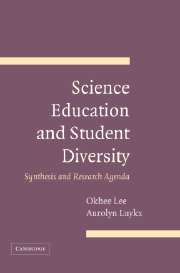Book contents
- Frontmatter
- Contents
- Foreword by Roland G. Tharp
- Acknowledgments
- Introduction
- SECTION I CONCEPTUAL GROUNDING AND POLICY CONTEXT
- 1 Student Diversity and Science Outcomes
- 2 Conceptual Frameworks and Educational Policies
- SECTION II STUDENT LEARNING AND CLASSROOM PRACTICES
- SECTION III CREATING EQUITABLE LEARNING ENVIRONMENTS
- SECTION IV CONCLUSIONS AND A RESEARCH AGENDA
- Appendix: Method for Research Synthesis
- References
- Index
1 - Student Diversity and Science Outcomes
Published online by Cambridge University Press: 04 December 2009
- Frontmatter
- Contents
- Foreword by Roland G. Tharp
- Acknowledgments
- Introduction
- SECTION I CONCEPTUAL GROUNDING AND POLICY CONTEXT
- 1 Student Diversity and Science Outcomes
- 2 Conceptual Frameworks and Educational Policies
- SECTION II STUDENT LEARNING AND CLASSROOM PRACTICES
- SECTION III CREATING EQUITABLE LEARNING ENVIRONMENTS
- SECTION IV CONCLUSIONS AND A RESEARCH AGENDA
- Appendix: Method for Research Synthesis
- References
- Index
Summary
A focus on student diversity presumes that educational decisions, from statewide policies to individual classroom practices, may affect different student populations differently. Therefore, while the various aspects of student diversity are reflected in differing science outcomes, the ways in which policies and schools define, delimit, and manage student diversity may affect outcomes at least as much as does “diversity” itself. Regardless of the origin or nature of students' marginalization, academic success depends to a significant degree on assimilation to mainstream cultural and linguistic norms, for example, particular ways of structuring narratives, displaying competence, or interacting with adults, not to mention the phonological and grammatical conventions of standard English (Delpit, 1995; Heath, 1983). Traditional science instruction generally assumes that students have access to certain educational resources at home (such as computers, or adults with the time and academic skills to help with homework), and it requires students living in poverty to adopt learning habits that necessitate a certain level of socioeconomic stability (such as a quiet place to study, and freedom from child care or work-related responsibilities). While some students may overcome these barriers to academic success through exceptional talent, effort, or family support, the existence of such individuals does not negate the inequity of their educational circumstances or the need for social solutions to what are social, not individual, problems. Such issues must be taken into account in interpreting gaps in science outcomes among diverse student groups and in devising instructional programs to close the gaps.
- Type
- Chapter
- Information
- Science Education and Student DiversitySynthesis and Research Agenda, pp. 9 - 22Publisher: Cambridge University PressPrint publication year: 2006



